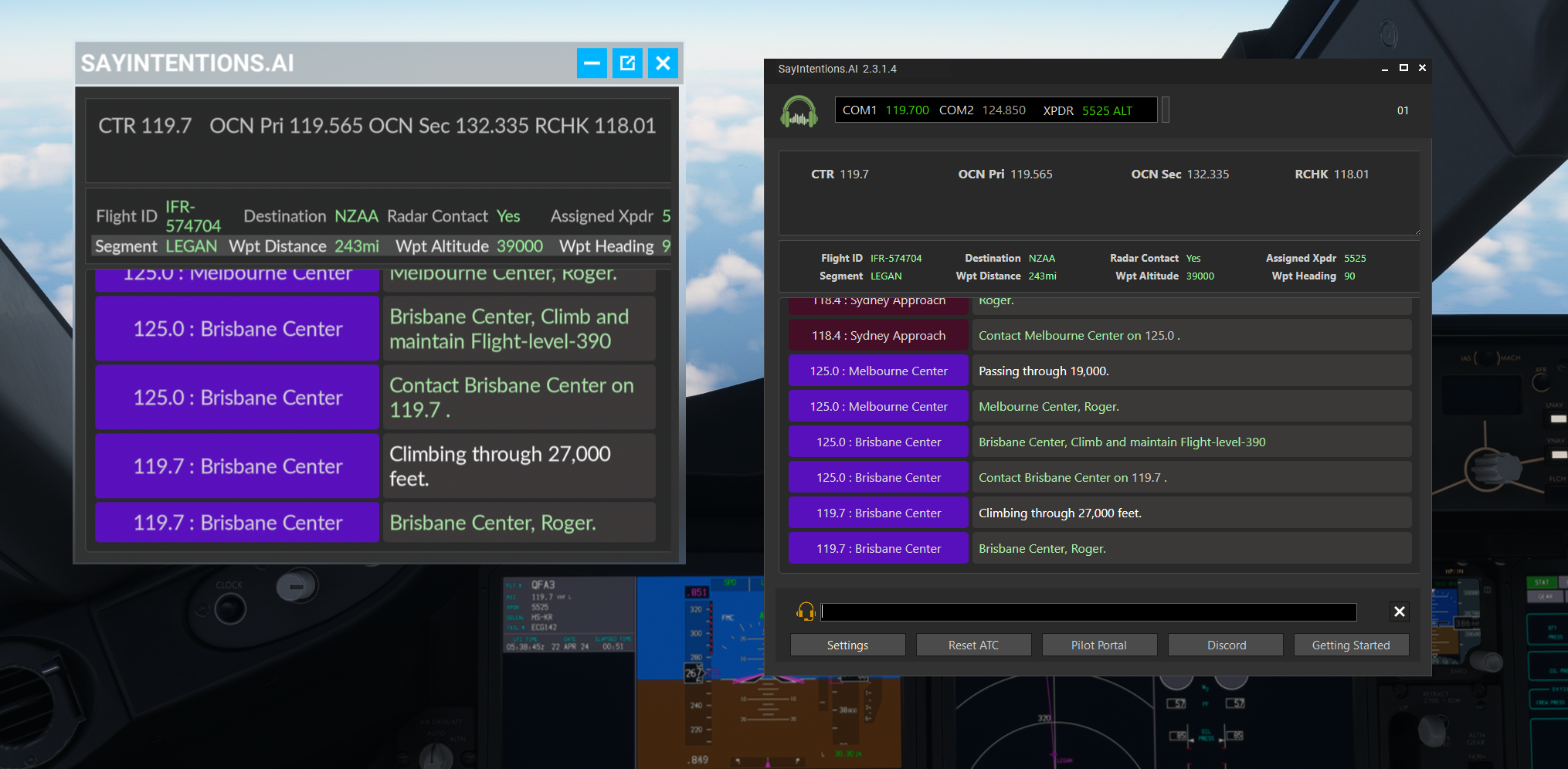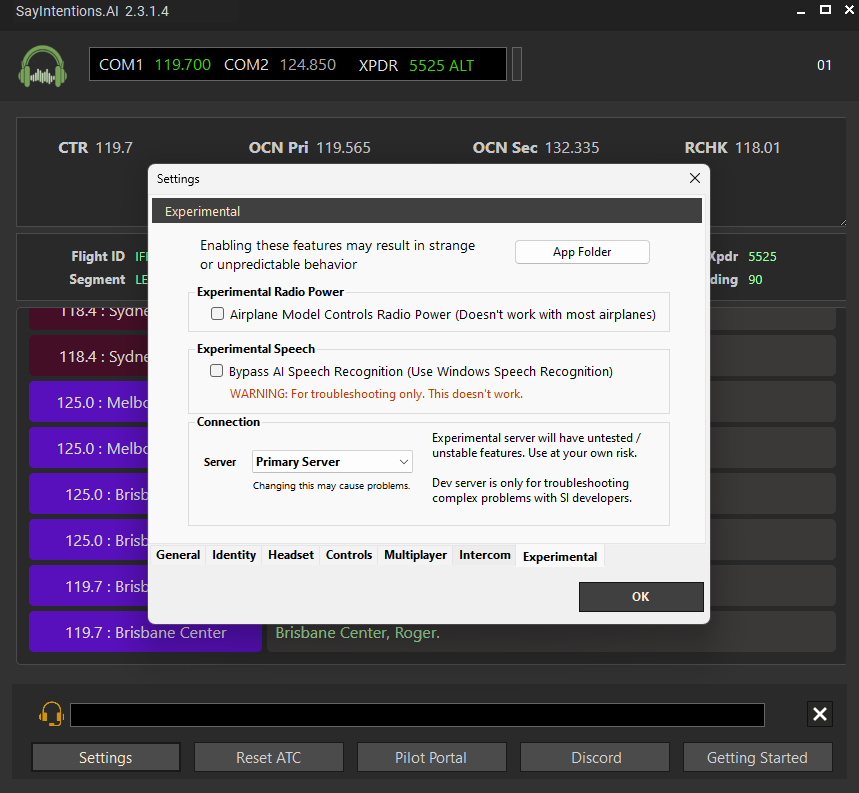
Microsoft Flight Simulator PMDG 777 Release Date Announced
June 17, 2024
PMDG 777-300ER Trailer Released
June 20, 2024Beyond ATC Vs Sayintentions.ai
The first thing we need to understand is both of these programs are still in development and changes are being made to both of these products. Both of these products focus on different things - to a degree (I'll get into it) So keep an open mind, when reading though as changes may have been made when you read this.

Let's talk about AI in Flight Simulators, it's the first we've seen these cutting edge AI technologies in Flight Simulators in these forms (Using language models) It's proven to be very effective and an amazing addition to the simulator for people seeking that bit more realism.

Starting with Sayintentions.ai, they offer truly limitless opportunities within communication to the Air Traffic Control, being able to talk and ask questions related in and out of the Simulator. However the small caveat is that Sayintentions.AI focuses mainly only on VFR Flying however, this doesn't mean you can't do IFR - From my review, you'll see it is capable of IFR flying just being more limited and can be slightly buggy. With Sayintentions.AI you're able to just jump into your flight, tune in, and start talking to Air Traffic Control right away. However say intentions lack UI compared to Beyond ATC, sayintentions.ai will still be in development feels like it's still in development (which is fine. Beyond ATC just feels a lot more polished of a product in terms of its layout and instruction

Now let's take a look at Beyond ATC, Beyond focuses more on IFR and feels a lot more polished of a product with a sleek UI and fair better pricing model - offering a once-off payment instead of a monthly subscription (Kind Of) If you want to use "Premium" Voice models it'll use credits which you'll have to buy when you want to use these modes, however Beyond ATC has a no cost option which is still sound amazing. Beyond ATC at the time of writing this doesn't support VFR and only supports IFR with the requirement of using Simbreif. Beyond ATC also offers a button option if you don't want to talk to ATC with preselected options to get you through your flight fully, which I think is great. However, it's also one of its biggest downfalls - At the moment you only have select statements you can communicate with Air Traffic Control. If you ask questions that aren't already listed or programmed it won't understand what you saying. However with that said there are more than enough options in your communications to do full flights with vectoring, just don't expect any small talk over the coms.
Check out Sayintentions.ai Here
Check out Beyond ATC Here


Both Products have benefits and cons - personally Beyond ATC feels a lot more polished off of a product from the whole experience however is a lot more limiting in what you can do. In Flight Simulator, you'll have only preselected statements of communication and no personal touches to the communication and planning to flight, you can't just jump into the simulator and go. Whereas with sayintentions.ai you can jump straight into the simulator and have limitless communication opportunities with Air Traffic Control but the UI and product don't feel as nice.

Pricing
In terms of pricing Beyond ATC at the moment takes the cake hands down, Offering a once-off payment is a much better option than charging monthly - Something I hope Sayintentions.ai changes in the future to offer a once off payment instead of a subscription model
Sayintentions.ai - $30 USD Per Month
Beyond ATC - $30 USD Once Off - then credits when needed

IFR Flying
It is a hard battle but I think Beyond ATC takes the cake, as it has been built from the ground up to support IFR, however, Sayintentions.ai does come in a close second - Sayintentions.ai sometimes on the STARS (arrivals) will get confused and send you in the wrong directions or give incorrect information.

VFR Flying
Hands down is Sayintentions.ai for a big reason being Beyond ATC doesn't support VFR at all at the moment, meaning you must use Simbreif and file a flight plan before flying and it must be IFR
Depending on what you're doing, if you're mostly flying IFR then Beyond ATC is a great option for you - which means you'll only have to make a once-off payment. However, if you mostly do VFR, don't consider Beyond ATC yet, as it isn't supported (YET) They have planned to add VFR to their product. Sayintentions.ai can also do IFR it can just be a bit more buggy and also means you'll be paying a monthly subscription.

The choice is up to you at the end of the day, I personally like Sayintentions.ai more however - their pricing model at the moment is out of my budget. So I've got Beyond ATC and will every so often pay for Sayintentions.ai when I want to do VFR Flying.
Disclaimer: Everything in this post is my personal opinion. I'm not a professional, and this isn't advice. I try my best to provide accurate information, but I can't guarantee it's all correct all the time. So I cannot be held responsible for any decisions you make based on what you read here


